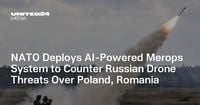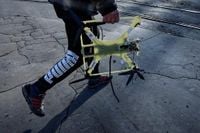In a decisive move to bolster its eastern defenses, NATO has begun deploying the American-made Merops counter-drone system along its borders with Russia, particularly in Poland and Romania. This comes as a direct response to a surge in Russian drone incursions that have exposed significant vulnerabilities in the alliance’s airspace security, according to reports from The Associated Press and other news outlets on November 6, 2025.
The urgency behind this deployment is rooted in a series of recent incidents. In early September, approximately 20 Russian drones breached Polish airspace during strikes on Ukraine, prompting the scramble of multimillion-dollar NATO jets to intercept them. While these advanced jets are formidable, the cost disparity is stark: each Russian drone costs tens of thousands of dollars, while the jets and their missiles represent investments in the tens of millions. As Colonel Mark McLellan of NATO Allied Land Command put it, "It’s able to target the drones and take them down and at a low cost as well. It’s a lot cheaper than flying an F-35 into the air to take them down with a missile."
Romania faced its own scare in October, when four military aircraft were dispatched to monitor Russian attacks near its border. Although no drones crossed into Romanian territory, the defense ministry authorized pilots to shoot down any UAVs that did. Meanwhile, Denmark reported unidentified drones over both military and civilian sites, pushing the government to impose a nationwide ban on civilian drone flights. Violators now face up to two years in prison.
These incursions didn’t stop at national borders. Airports in Copenhagen, Munich, Berlin, and Brussels were temporarily closed due to drone sightings, and there were additional reports of drones near military bases in Belgium and Denmark. Denmark’s Defence Minister Troels Lund Poulsen remarked that a "professional actor" was behind the drone flights over multiple airports, underscoring the complexity and seriousness of the threat.
The Merops system represents NATO’s answer to this evolving challenge. Small enough to fit in the back of a midsize pickup truck, Merops is a modular counter-unmanned aerial system (C-UAS) that leverages a combination of radar, electro-optical and infrared (EO/IR) cameras, and artificial intelligence algorithms to detect and classify small drones. Once a threat is identified, the system routes targets to a local command and control (C2) hub for either manual or automated decisions. It can neutralize hostile UAVs by jamming their signals or, uniquely, by launching small interceptor drones that physically take down or divert the threat.
What sets Merops apart is its ability to operate under conditions where traditional guidance systems might fail. Its interceptors use autonomous navigation, allowing them to function even when GPS signals are jammed or electronic warfare is underway. The system’s design emphasizes rapid transport and deployment, but its effectiveness can still depend on sensor quality, weather, and the scale or complexity of incoming attacks.
Brigadier General Thomas Lowin, deputy chief of staff operations at NATO Allied Land Command, explained, "Merops gives commanders a certain amount of time to be able to assess the threat and decide — to shoot or not shoot." This flexibility is crucial, as drones often fly low and slow, making them difficult to spot on radars calibrated for high-speed missiles. Sometimes, drones can be mistaken for birds or even small planes, but Merops helps fill those detection gaps, providing a critical edge in a rapidly changing battlefield.
The deployment in Poland and Romania is just the beginning. Denmark has also decided to acquire the Merops technology, and NATO officials told The Associated Press that the system will be part of a broader effort to fortify the alliance’s eastern flank. The ultimate goal, they say, is to create a border so well-defended—from Norway in the north to Turkey in the south—that Moscow’s forces will be deterred from ever contemplating a crossing.
This strategy is not happening in isolation. European Union countries have agreed to work together to create a "drone wall" on the bloc’s eastern border, while U.S. military leaders in Europe are advocating for an Eastern Flank Deterrence Line—a layered zone of defenses equipped with a network of sensors and a command-and-control system adaptable to evolving technologies. General Chris Donahue, head of NATO’s Allied Land Command, emphasized the need to offset Russia’s manpower advantage—thanks to its large conscript military—by leveraging NATO’s technological superiority. "The alliance needs to build defenses that offset that manpower advantage by using its technological capabilities," Donahue stated.
The Merops system has already proven its worth in Ukraine, which has become a crucible for drone warfare innovation. Brigadier General Lowin noted, "If something doesn’t work there, it’s probably not worthwhile acquiring." Ukrainian forces have reportedly used similar interceptor drones to destroy over 2,000 Russian UAVs, including at least 17 Shahed drones, as part of a cost-effective defense program on the front lines.
The race for technological supremacy in drone warfare is not one-sided. Russia, too, is rapidly adapting. President Vladimir Putin publicly acknowledged in early October that Russia’s military had significant knowledge gaps at the outset of the Ukraine conflict, stating, "There were entire fields where our knowledge was simply non-existent," but he claimed Russia is now able to field more advanced technology "within a matter of days." Russian forces are mass-producing attack drones equipped with cameras, jet-propelled engines, and advanced anti-jamming antennae, forcing NATO and Ukraine into a relentless game of technological cat-and-mouse.
European companies are also stepping up, developing new technologies including drone-against-drone systems like Merops and specialized anti-drone missiles. The development and deployment of these systems are part of a broader NATO strategy, forecast to take two to five years, to build a robust, layered defense along the alliance’s eastern border.
Former Google CEO Eric Schmidt has reportedly invested in Merops, though both he and the company have kept a low public profile, declining requests for interviews. Defense officials from Poland and Romania have also refrained from public comment, reflecting the sensitivity and high stakes of this technological arms race.
As the war in Ukraine approaches its fourth year, the lessons learned on those battlefields are shaping the future of European security. The deployment of Merops is just the first step in a long-term effort to ensure that NATO’s eastern flank is ready for whatever challenges may come next.






